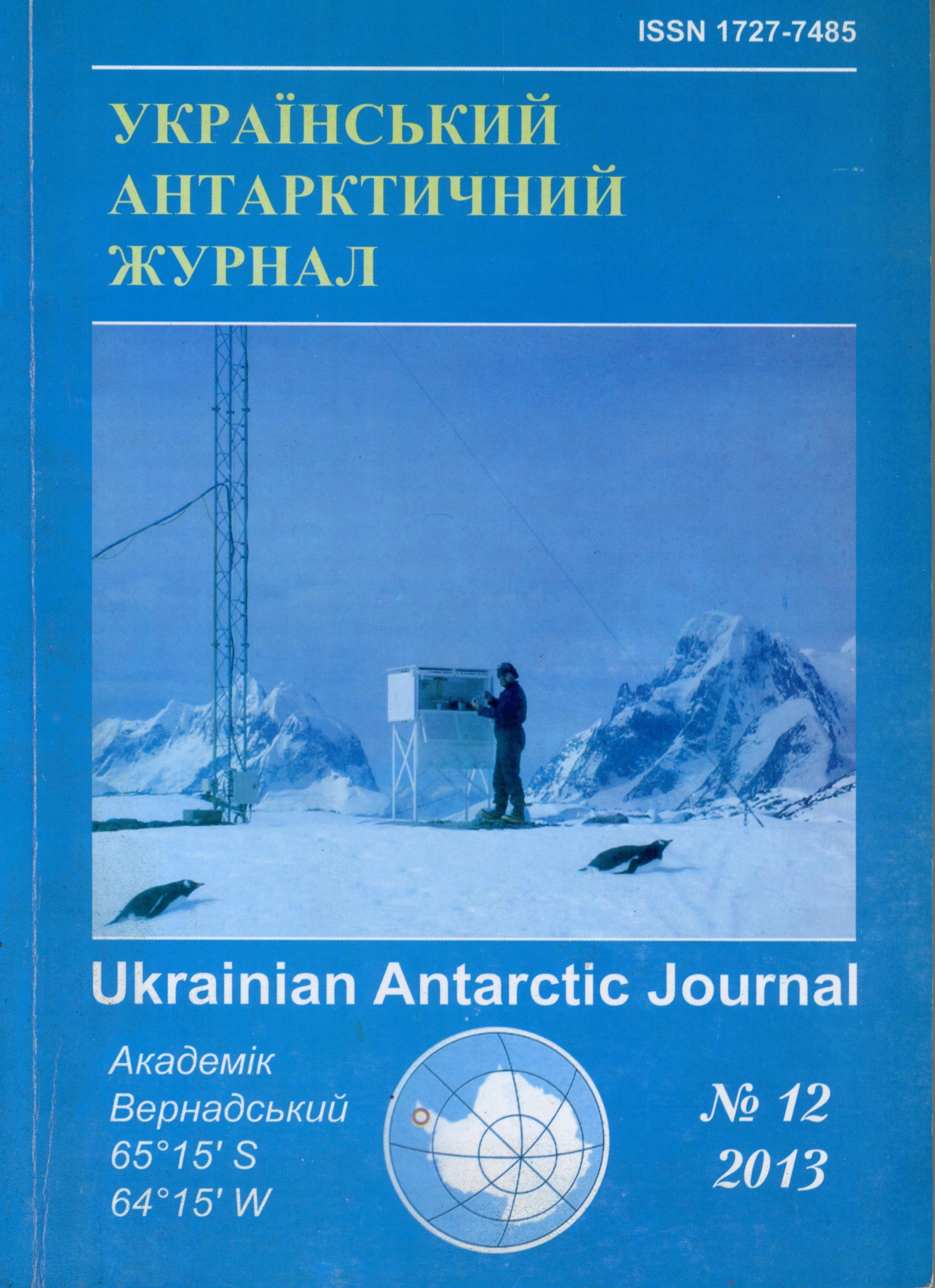New crustal models of Drake Passage and the hydrocarbon reservoir searching in the Antarctic Peninsula continental margin structures (by the 17th Ukrainian Antarctic Expedition results)

This work is licensed under a Creative Commons Attribution-NonCommercial-NoDerivatives 4.0 International License.
Abstract
During the 17th Ukrainian Antarctic Expedition (UAE, 2012) new geophysical data for the West Antarctica bottom structures were obtained. The geophysical investigations included the geoelectric methods of forming a short-pulsed electromagnetic field (FSPEF), vertical electric-resonance sounding (VERS) and the special method of remote sensing (RS) satellite data processing and interpretation. These methods were used for the crustal structure studying and the hydrocarbon accumulations searching in continental margin bottom structures. Detailed geoelectric sections (with depth up to 24km) were constructed for Drake Passage, Scotia Sea and Bransfield Strait tectonic structures as a result of these seasonal works. There are presented some crustal boundaries between stratigraphically heterogeneous layers and deep depth discontinuities. The occurrence of complex fault zones near the coast of South America and the Antarctic Peninsula are showing. Some specific geoelectric boundaries below the Moho presence and the occurrence of possible deep high-temperature zones of rocks may reflect the heterogeneity of Passage bottom structures and available processes of tectonic and magmatic activity with the local areas of modern rifting.
Some anomalies of "oil deposit" type with total area of about 900 km2 and three new anomalous zones of the "deposit of gas hydrates" type were mapped in the UAS "Academician Vernadsky" area. These data support the assumption of the possible existence new oil and gas area in this part of the West Antarctica. The parameters of two anomalous zones of the "deposit of gas hydrates" type with total thickness of 100 - 500m were determined at the continental slope of the South Shetland Islands. The presence of a number of "satellite" anomalous zones beyond the identified anomalies within the BSR-zones shows that gas hydrate reserves of this area are higher than previously calculated.
New detailed data for local gas hydrate accumulations confirm the high potential perspectives of this part of the South Shetland margin and allow attributing it to one of the most promising areas of the Antarctic region.
References
- Ashcroft, W.A. (1972). Crustal structure of the South Shetland Islands and the Bransfield Strait, British Antarctic Survey Scientific Reports, 66.
- Bakhmutov, V., Solovyov, V., Korchagin, I. et al. (2010). Drake Passage: crustal structure, tectonic evolution and new prognosis for local HC accumulations along the Antarctic Peninsula margin. An International Conference on "Geodynamical phenomena: From Observations and Experiments to Theory and Modelling". 20-24 September 2010, Kyiv, Ukraine. Geophysical journal, 32(4), 12-15.
- Barker, P.F., Dalziel, W.D., & Storey, B.C. (1991). Tectonic development of the Scotia Arc region. The Geology of Antarctica. Oxford. pp. 215-248.
- Grad, M., Guterch, A., & Janik, T. (1993). Seismic structure of the lithosphere across the zone of subduced Drake Plate under the Antarctic Plate, West Antarctica. Geophysical Journal International, 115, 568-600.
- Janik, T., Sroda, P., Grad, M. et al. (2006). Moho depth along Antarctic Peninsula and Crustal structure асross Landward Projection on Hero fracture zone. Antarctica: Contributions to global Earth sciences. Berlin Heidelberg New York, Springer-Verlag. (pp. 229-236).
- Jin, Y.K., Lee, M.W., Kim, Y. et al. (2003). Gas hydrate volume estimations on the South Shetland continental margin, Antarctic Peninsula. Antarctic Science, 15(2), 271-282.
- Levashov, S.P., Yakymchuk, N.A., Korchagin, I.N. et al. (2012). Methodological aspects of the remote sensing data processing and interpretation technology in oil and gas prospecting of offshore. Geoinformatika, 1, 5-16.
- Levashov, S.P., Yakymchuk, N.A., & Korchagin, I.N. (2010). New possibilities for rapid assessment of hydrocarbon potential exploration areas, inaccessible and remote areas, licensing of blocks. Geoinformatika, 3, 22-43. (in Russian).
- Levashov, S.P., Yakymchuk, N.A., Korchagin, I.N. et al. (2007). Drake Passage and Bransfield Strait –new geophysical data and modelling of the crustal structure. In: A.K. Cooper, C.R. Raymond et al. (Eds.), Antarctica: A Keystone in a Changing World -Online Proceedings of the 10th ISAES X, USGS Open-File Report 2007-1047.
- Levashov, S.P., Kozlenko, Ju.V., Korchagin, I.N. et al. (2006). Crustal inhomogeneities of Drake Passage lithosphere structures. Geosciences –To Discover and Develop. International Conference and Exhibition. 15-18 October 2006. Lenexpo, Saint Petersburg, Russia. CD-ROM Abstracts volume. P000, 4 pages.
- Levashov, S.P., Yakymchuk, N.A., Korchagin, I.N. et al. (2004). Electric-resonance sounding method and its application for the ecological, geological-geophysical and engineering-geological investigations. 66th EAGE Conference & Exhibition, Extended Abstracts P035.
- Lodolo, E., Camerlenghi, A., Madrussani, G. et al. (2002). Assessment of gas hydrate and free gas distribution on the South Shetland Margin (Antarctica) based on multichannel seismic reflection data .Geophysical Journal International, 148, 103-119.
- Loreto, M.F., Tinivella, U., Accaino, F. et al. (2011). Offshore Antarctic Peninsula Gas Hydrate Reservoir Characterization by Geophysical Data Analysis. Energy, 4, 39-56.
- Schenke, H.W., & Udintsev, G.B. (2009). The Central Scotia sea-floor – is it an paleo-oceanic plate, an young rifted plate or an paleo-land Scotia? Ukrainian Antarctic Journal, 8, 36-45.
- Solovyov, V.D., Bakhmutov, V.G., Korchagin, I.N. et al. (2011). Gas Hydrates Accumulations on the South Shetland Continental Margin: New Detection Possibilities. Hindawi Publishing Corporation. Journal of Geological Research, 2011, Article ID 514082.
- Yegorova, T., Bakhmutov, V., Gobarenko, V. et al. (2009). New insight into the deep structure of Antarctic Peninsula continental margin by methods of 2-D Gravity. Magnetic modeling and 3-D seismic tomography. Ukrainian Antarctic Journal, 8, 46-66.
- Tinivella, U., Accaino, F., & Camerlenghi, A. (2002). Gas hydrate and free gas distribution from inversion of seismic data on the South Shetland margin (Antarctica). Marine Geophysical Researches, 23, 109-123.

